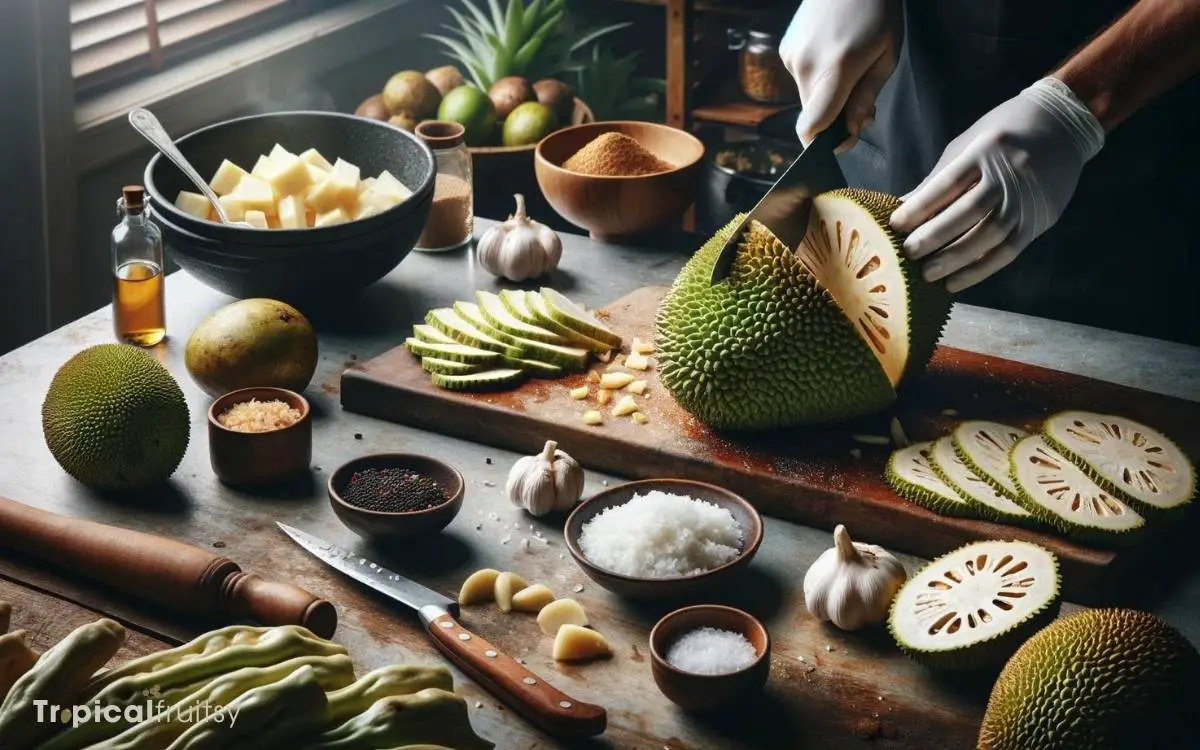How to Cook Ulu Breadfruit? 6 Easy Steps!
Cooking ulu (breadfruit) can be simple and rewarding, providing a delicious and nutritious addition to your meals.
To ensure a perfect dish, select a ripe ulu, prepare it properly by removing the skin and core, and choose a cooking method such as roasting, boiling, or frying to enhance its natural flavors.
Ulu, also known as breadfruit, is a tropical fruit that requires proper selection and preparation before cooking.
Here are some quick steps:
Transform ulu into a culinary delight with the right preparation and cooking technique, enhancing your dining experience.

Key Takeaway
Step 1: Selecting the Perfect Ulu

A chef’s success in cooking ulu breadfruit begins with the crucial step of selecting a ripe, unblemished fruit.
Careful scrutiny is paramount; look for a ulu that exhibits a rich, golden-brown hue, indicating it has reached its peak maturity. The surface should be free of cuts and bruises, which can affect the fruit’s internal quality.
One should also assess the give under gentle pressure; a slight softness suggests the ulu’s flesh is creamy and ready for culinary transformation.
The aroma is another telltale sign – a subtle, sweet fragrance emanates from a ripe ulu, inviting the promise of a delectable meal.
With the perfect breadfruit in hand, the journey from tree to table progresses seamlessly to the next critical phase: preparing your breadfruit for cooking.
Step 2: Preparing Your Breadfruit

Upon securing a ripe ulu, the art of preparation begins, an essential step to unlock the fruit’s culinary potential.
Expert peeling techniques are imperative to retain the flesh’s integrity, ensuring a seamless transition to the cutting phase.
Mastering various cutting styles, guided by the intended culinary application, allows the chef to craft dishes that highlight the breadfruit’s versatility and nuanced flavors.
Selecting Ripe Ulu
Before cooking ulu breadfruit, it is crucial to select a ripe specimen, as the fruit’s maturity level significantly influences its flavor and texture.
The ripe ulu exhibits certain characteristics that are key indicators of its readiness for culinary use.
Discerning the perfect stage of ripeness ensures that the breadfruit will provide the desired sweetness and softness, or alternatively, a firmer texture if slightly underripe, which is preferable for certain dishes.
- Skin Color: Look for a fruit whose green skin has turned a yellowish hue, with perhaps a few brown patches, indicating a mature ulu.
- Softness: Gently press the surface; a ripe ulu will yield slightly to pressure, similar to a ripe avocado.
- Fragrance: A sweet, aromatic smell is a telltale sign of a ripe breadfruit ready for cooking.
Peeling Techniques
After selecting a ripe ulu, the next step involves peeling the fruit using one of several effective techniques to prepare it for cooking.
Begin by washing the ulu thoroughly under running water to remove any surface dirt.
Position the breadfruit on a stable cutting board. You may opt to slice off the stem and base to create a flat surface for increased stability.
Using a sharp knife, make a shallow incision through the skin around the circumference of the ulu, being careful not to cut too deeply into the flesh.
Then, peel away the skin in sections, starting from the top and pulling downwards. This technique requires precision to minimize wastage of the succulent flesh beneath the skin, ensuring a bountiful yield for your culinary endeavors.
Cutting Styles
Once peeled, the ulu breadfruit can be cut into various shapes and sizes, depending on the intended recipe and cooking method. The versatility of ulu allows it to be transformed into a variety of culinary delights.
The texture and density of the breadfruit make it an excellent candidate for numerous cooking styles, each requiring its own unique cut.
Here are three common cutting styles:
- Cubed: Ideal for stews or curries, where the breadfruit absorbs flavors and maintains its form.
- Slices: Perfect for pan-frying or baking, providing ample surface area for a crispy exterior and tender interior.
- Wedges: Suitable for roasting or deep-frying, creating hearty pieces with a satisfying mouthfeel.
Each cutting style enhances the breadfruit’s culinary potential, ensuring a delightful eating experience.
Step 3: Choosing a Cooking Method

Selecting an appropriate cooking method for ulu breadfruit is paramount, as it directly correlates with the fruit’s ripeness and the final texture one aims to achieve.
While a less mature ulu may be ideal for methods that require a firmer texture, such as frying or roasting, a fully ripe breadfruit lends itself to boiling or steaming, resulting in a softer, more custard-like consistency.
Understanding the nuances of each cooking technique will ensure that the unique qualities of the breadfruit are highlighted, culminating in a dish that is both delectable and texturally appealing.
Ripeness Determines Method
The ripeness of the ulu breadfruit significantly influences the appropriate cooking technique to be employed.
As a culinary chameleon, ulu’s texture and flavor profile evolve with maturity, necessitating a discerning approach to its preparation.
Firm, immature ulu is best suited to boiling or frying, where it can emulate the consistency of a potato. A semi-ripe ulu, slightly softer, lends itself to baking, allowing its subtle sweetness to emerge.
Fully ripe ulu, with its creamy texture and sweet taste, is excellent for desserts, often simply baked or used in recipes as a custard substitute.
- Firm Ulu: Ideal for boiling or frying to achieve a potato-like texture.
- Semi-Ripe Ulu: Suited for baking, enhancing its inherent sweetness.
- Fully Ripe Ulu: Perfect for sweet dishes where it can be baked or used as a substitute for custard ingredients.
Desired Texture Outcome
Ulu breadfruit’s culinary versatility allows for a variety of textures, from crunchy to creamy, depending on the chosen cooking method.
To achieve a crisp exterior with a tender heart, one might opt for roasting slices of ulu until a golden crust forms. This method accentuates the breadfruit’s inherent sweetness and provides a satisfying contrast in textures.
Alternatively, steaming the ulu whole or in chunks unlocks a supple, velvety consistency ideal for mashes or purees, blending seamlessly into both savory and sweet applications.
The meticulous art of cooking ulu requires an understanding of how heat transforms its starchy composition, enabling chefs to tailor the texture to complement the intended dish, thus ensuring the perfect culinary creation.
Step 4: Mastering Roasted Ulu

To master roasted ulu, one must first preheat the oven to an optimal temperature to ensure even cooking. This initial step is crucial as it sets the stage for the ulu to develop a golden exterior while retaining its succulent interior.
The process of roasting transforms the starchy fruit into a dish with a complex flavor profile and a satisfying texture.
- Selection: Choose an ulu that is firm to the touch with a greenish-yellow skin; maturity affects the texture.
- Preparation: Slice the ulu into even pieces to promote uniform roasting and season with a drizzle of olive oil and a pinch of salt.
- Roasting Time: Monitor the ulu closely, as roasting times can vary depending on size and oven efficiency.
Step 5: Trying Boiled Breadfruit

Following the exploration of roasted ulu, the culinary journey persists with the method of boiling breadfruit, which offers a simpler yet equally delectable alternative.
This technique emphasizes the subtle, sweet nuances inherent in ulu, presenting a texture akin to that of a boiled potato but with a tropical twist.
To commence, select a mature, yet firm ulu and dissect it into uniform wedges, expunging the heart and seeds. Submerge these sections in ample water, introducing a pinch of salt to elevate the natural flavors.
The boiling process, lasting approximately 20 to 30 minutes, will transmute the starchy wedges into a tender, versatile staple.
Once tender to the fork’s touch, drain and serve. This method unveils the ulu’s potential as a foundational canvas for both savory and sweet culinary compositions.
Can Ulu Breadfruit be used as an alternative in Breadfruit Curry?
The versatile Ulu breadfruit can indeed be used as an alternative in a breadfruit curry recipe tutorial. Its starchy texture and mild flavor make it a great addition to this traditional dish. So, if you’re looking for a new twist on a classic recipe, give Ulu breadfruit a try!
Step 6: Serving and Pairing Ideas

Experiment with boiled ulu by incorporating it into diverse culinary creations, ranging from savory mashes to sweet desserts, or pairing it with proteins and spices that complement its unique flavor profile.
The starchy nature of ulu breadfruit makes it a versatile canvas for a myriad of dishes.
When conceptualizing meal pairings and serving suggestions, consider the following:
Savory Combinations:
- Pair with coconut milk and curry spices for a tropical-inspired side dish.
- Incorporate into a root vegetable hash, seasoned with fresh herbs and served alongside grilled fish or chicken.
- Mash with garlic, olive oil, and a touch of nutmeg for a comforting alternative to traditional mashed potatoes.
Each of these ideas honors the delicate, slightly sweet taste of ulu, while providing a platform for its texture to shine.
Conclusion
In a twist of culinary fate, the once overlooked ulu emerges as the star of diverse dishes, its versatility showcased from the glowing embers of a roast to the gentle bubbles of a boil.
The breadfruit, once a mere sustenance, now graduates to a delicacy, its flesh transformed into a canvas for culinary artistry.
Amidst the symphony of flavors, ulu stands as a testament to the ingenuity in simplicity, a humble ingredient ascended to gastronomic prominence.






